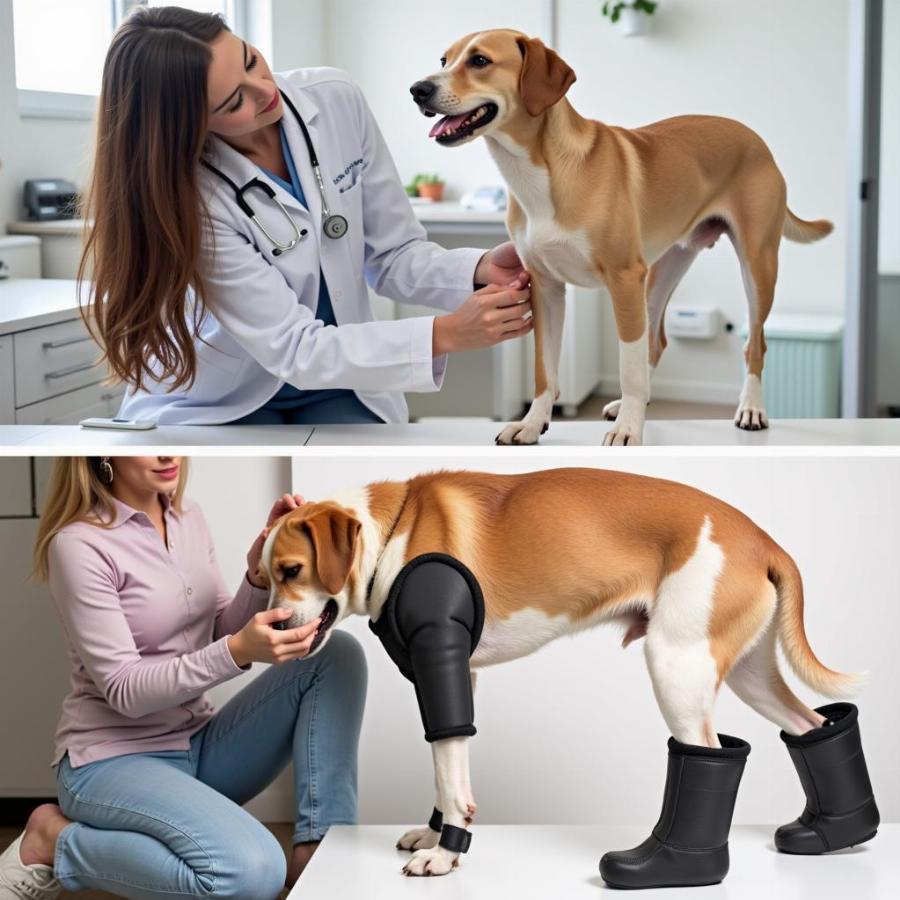A dog’s hind legs are essential for mobility, power, and overall well-being. Understanding their structure, function, and potential problems can help you keep your furry friend happy and healthy. Whether you’re curious about why your dog moves the way they do, or concerned about a potential issue with their hindquarters, this comprehensive guide will provide you with valuable insights into the world of dog hind legs. We’ll cover everything from anatomy and common ailments to preventative care and treatment options.
The Anatomy of Canine Hind Legs
A dog’s hind legs are complex structures designed for power and propulsion. The key components include the hip joint, femur (thigh bone), stifle (knee), tibia and fibula (shin bones), tarsus (hock), metatarsals (paw bones), and phalanges (toes). The muscles, ligaments, and tendons work together to facilitate movement, allowing your dog to run, jump, and navigate their world. The powerful muscles in the hindquarters generate the force needed for these activities. The ligaments provide stability to the joints, while the tendons connect muscles to bones.
Understanding this intricate system is crucial for recognizing potential issues and providing appropriate care. For example, knowing the location of the stifle can help you pinpoint the source of lameness or discomfort.
Common Hind Leg Problems in Dogs
Several issues can affect a dog’s hind legs, ranging from minor injuries to more serious conditions. Some common problems include:
- Hip Dysplasia: A genetic condition where the hip joint doesn’t develop properly, leading to pain, lameness, and arthritis.
- Cruciate Ligament Tears: Similar to ACL tears in humans, these injuries can cause instability and pain in the stifle joint.
- Luxating Patella: A condition where the kneecap dislocates, causing lameness and discomfort.
- Arthritis: Inflammation of the joints, often caused by age, injury, or underlying conditions.
- Muscle Strains and Sprains: Injuries to the muscles or ligaments, often caused by overexertion or trauma.
Recognizing the signs of these problems is essential for early intervention. Symptoms can include limping, difficulty standing or walking, stiffness, swelling, and pain. If you notice any of these signs, it’s crucial to consult a veterinarian.
Caring for Your Dog’s Hind Legs
Maintaining your dog’s hind leg health involves a combination of preventative care and prompt treatment. Here are some key strategies:
- Regular Exercise: Appropriate exercise helps strengthen muscles and maintain joint health. However, avoid overexertion, especially in puppies and senior dogs.
- Weight Management: Maintaining a healthy weight reduces stress on the joints and can help prevent or manage conditions like arthritis. Consult dog hind legs weak for further details.
- Supplements: Supplements like glucosamine and chondroitin can support joint health and may help alleviate symptoms of arthritis.
- Regular Veterinary Checkups: Routine checkups can help detect potential problems early on, when treatment is often most effective.
- Proper Nutrition: A balanced diet provides the essential nutrients for healthy bones, joints, and muscles.
“Early intervention is key to managing hind leg problems in dogs,” says Dr. Emily Carter, a veterinary orthopedic specialist. “Regular checkups and a proactive approach to care can significantly improve your dog’s quality of life.”
What to Do If Your Dog is Experiencing Hind Leg Issues
If your dog exhibits any signs of hind leg problems, consult a veterinarian immediately. They can diagnose the issue and recommend appropriate treatment options, which may include medication, physical therapy, surgery, or a combination of approaches. In some cases, assistive devices like a dog wheelchair for large dogs can help improve mobility and quality of life. Addressing the issue promptly can help prevent further complications and ensure your dog’s comfort and well-being. If you notice your dog losing balance in hind legs, it’s crucial to seek veterinary advice.
 Dog Receiving Hind Leg Treatment
Dog Receiving Hind Leg Treatment
Conclusion
Understanding your dog’s hind legs is essential for responsible pet ownership. By learning about their anatomy, common problems, and preventative care strategies, you can help keep your canine companion happy, healthy, and mobile. Remember, early intervention is key to managing hind leg issues effectively. If you have any concerns about your dog’s hind legs, don’t hesitate to contact your veterinarian. You can also explore dogs hind legs for more information.
FAQ
- What are the most common signs of hind leg problems in dogs? Limping, difficulty walking or standing, stiffness, swelling, and pain are common indicators.
- How can I prevent hind leg problems in my dog? Maintain a healthy weight, provide regular exercise, and schedule routine veterinary checkups.
- What are the treatment options for hind leg problems? Treatment varies depending on the specific issue and can include medication, physical therapy, surgery, or assistive devices.
- Can diet affect my dog’s hind leg health? Yes, a balanced diet is crucial for maintaining healthy bones, joints, and muscles.
- When should I contact a veterinarian about my dog’s hind legs? Contact a veterinarian immediately if you notice any signs of discomfort or lameness.
- Are certain breeds more prone to hind leg problems? Yes, some breeds are genetically predisposed to conditions like hip dysplasia.
- How can I make my dog comfortable if they are experiencing hind leg pain? Provide a comfortable bed, avoid strenuous activity, and follow your veterinarian’s recommendations for pain management.
Related Questions and Further Reading
- How can I tell if my dog has hip dysplasia?
- What are the different types of cruciate ligament injuries in dogs?
- What is the recovery process like for hind leg surgery in dogs?
Beaut Dogs is your go-to resource for all things related to dog care, offering expert advice and valuable insights into the world of canine companions. From breed information to health and nutrition guidance, Beaut Dogs provides the knowledge you need to be the best pet parent possible. When you need support, please contact Email: [email protected] for detailed and accurate answers from Beaut Dogs. Visit https://beautdogs.com today!